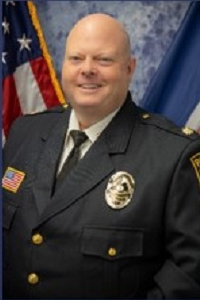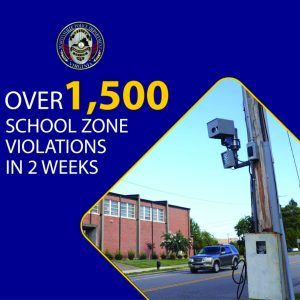In a two-week period, more than 1,500 school zone speeding violations have been issued in the City of Martinsville. Police Chief Robert “Rob” Fincher said these violations occurred when vehicles exceeded the speed limit by 11 miles per hour or more while school zone lights were flashing.

“When the reduced speed limit is in effect, during the morning arrival and afternoon dismissal times, the lights flash to indicate the limit is 25 mph—or 15 mph at some schools,” Fincher said. “That’s about 30 minutes in the morning and 30 minutes in the afternoon.”
The enforcement cameras, which only operate when the lights are flashing, are designed to catch violators automatically. “We’ll continue to use regular speed enforcement methods, but the photo enforcement is consistent—if you speed while the lights are flashing, you’ll get caught,” Fincher said.
The system uses photo-enforcement cameras to identify speeding vehicles, though Fincher noted that an officer obtains the data and reviews each case, “just as if he was sitting on the side of the road,” before any warning or ticket is issued.
“Our traffic officer had 115 cases to review in just one day,” he said, stressing the importance of spreading awareness about the program and preventing a tragedy from occurring.
The city ordinance allows for a civil fine of $100 for speeding violations in school zones, where drivers exceed the limit by 11 mph or more. Currently, the department is issuing warnings during a grace period to inform the public. “In these first two weeks of warnings, we’ve seen over 1,500 violators. Our goal isn’t to send out tickets—we want people to slow down,” Fincher said.
The primary goal, Fincher emphasized, is to prevent tragedies. “Studies show that a pedestrian hit by a vehicle going 20 mph has about a 95 percent chance of survival, but at 40 mph, the chance drops to just 15 percent,” he said. With many students walking to and from school, the potential danger is real.

Fincher said that while the department hopes the warning period will encourage drivers to change their behavior, tickets will soon follow. “We don’t want to issue tickets, but sometimes the ‘carrot’ approach doesn’t work, and you have to use the ‘stick,’” he said. Even one of Fincher’s close friends received multiple warnings, which, he said, “opened his eyes.”
The grace period is expected to end before November, at which point $100 civil tickets will be issued. “We’re not announcing the exact date because we don’t want people to wait until the last minute to start obeying the law,” Fincher said.
Violations will result in a $100 fine, regardless of how far over the limit the vehicle is going. The ordinance is written to penalize the vehicle owner, not the driver, meaning no points will be added to the driving record. However, if fines aren’t paid, civil action will be taken to collect the penalty.
Fincher added that additional signage has been installed near school zones to warn drivers about the photo enforcement. Speed verification signs also alert drivers about how fast they’re going.
“Before entering the enforcement area, there are signs that say, ‘photo speed enforcement ahead,’ and then a speed verification sign shows how fast you’re going. Once the lights are flashing, the enforcement begins,” he explained.




